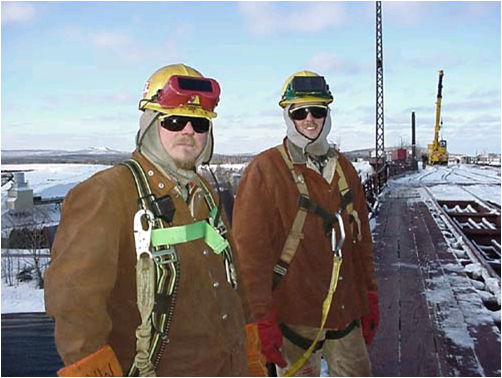Cold (Download)
COLD WEATHER Construction of Twins Baseball Stadium – Minneapolis, MN 1 Cold Weather: Definition Varies by region of the country “Cold” temperatures < 40 o F “Cool” temperatures (40 - 60 o F) Temperature information inferred from www.cdc.gov Taken from www.go-explore-trans.org 2 Common Cold Weather Elements Rain, freezing rain, snow, sleet, ice, and frost Damp or wet clothing makes the body feel colder Wind “wind chill” causes the air to feel colder than it really is Taken from www.cbc.ca 3 Wind Chill Effect 4 For Example: A temperature of 30 degrees Fahrenheit with a 40 mile per hour wind would feel like 13 degrees Fahrenheit. mph temp 20 25 30 35 40 60 -4 3 10 17 25 55 -3 4 11 18 25 50 -3 4 12 19 26 45 -2 5 12 19 26 40 -1 6 13 20 27 35 0 7 14 21 28 30 1 8 15 22 28 25 3 9 16 23 29 20 4 11 17 24 30 15 6 13 19 25 32 10 9 15 21 27 34 5 13 19 25 31 36 Hazards Loss of Grip Strength A study by Horvath and Freedman found that “grip strength decreased by one-fourth even though the cold exposure was of relatively short duration”. Could lead to dropping of equipment such has hammers or torches Horvath, S.M., and Freedman, A. The Influence of Cold upon the Efficiency of Man. Journal of Aviation Medicine, 18, 158-164, 1947. 5 Taken from journalistopia.com Hazards Hypothermia Lowered core body temperature Drop in blood pressure Mental confusion Death (if left untreated) 6 Core Temp (°F) Body’s Response 99.6 Normal body temperature 96.8 Metabolic rate increases 95 Pronounced shivering 91.4 Severe hypothermia 86 Consciousness loss begins 75.2 Pulmonary edema 68 Cardiac Standstill Hazards Frost Frost on roofs, scaffolding, ladders, etc, may present a danger of slipping and falling Leading cause of deaths in the construction industry due to cold weather Frostbite Occurs when the body constricts blood flow to extremities in order to preserve core body temperature Prolonged exposure will lead to permanent cell damage 7 Hazards Unpredictable Conditions Cold weather changes many of the conditions on the construction site such as soil Equipment may become frozen to the ground Trench conditions may become unpredictable Excavated soil can freeze, becoming dangerous if loose 8 Taken from flickr.com/photos/ alohadave/2194113460/ Fatalities 28 deaths attributed to cold weather conditions were investigated by OSHA from 1990 thru 2009 Most death cases are attributed to slips and falls due to frost, ice, and snow Frozen soil conditions are also causal factors Source: Extracted from OSHA Accident Investigation Data 1990-2009 9 Fatality Example A worker was staging bundles of shingles on the second story roof of a newly-constructed house. The worker was on the east side of the house near a valley when he slipped on frost or ice on the roof and fell 21 feet to the ground. He was transported to the hospital where he died the next day. Source: Extracted from OSHA Accident Investigation Data 1990-2009 10 OSHA Regulations 1926.451(a)(17) addresses snow buildup In a sample safety plan, OSHA regulations state: “ When wet weather (rain, snow, or sleet) are present, roof sheathing operations shall be suspended unless safe footing can be assured for those workers installing sheathing” Source: OSHA Regulations 1926 11 Best Practices PPE Care must be taken to properly cover all exposed skin with appropriate clothing made for the cold weather environment Cold Weather c lothing should: Provide high insulation Allow Moisture to escape Waterproof Shed snow Allow air flow Not restrict movement Have minimum weight and bulk 12 Best Practices Provide an on-site break area that is heated and dry Require warm-up breaks based on length of shift and experienced temperature Reduced visibility Use brightly colored signs Double check for workers in area Cease current construction work if visibility is significantly hampered by weather 13 Best Practices Environmental Awareness Checks should be made each morning for potential hazards that may have formed due to freezing overnight temperatures Strictly enforce pre-task planning and its documentation Training Train workers in avoiding consequences of cold weather exposure Train workers in recognizing symptoms of hypothermia, frostbite, cold stress, and other cold-related illnesses. 14 Best Practices Use the buddy system so workers are never working alone in isolated areas Food and Drink Be sure employees are staying well-hydrated Avoid caffeine, alcohol, and other drugs Consume high-calorie foods and sports drinks 15 Think Safety Work Safely 16

